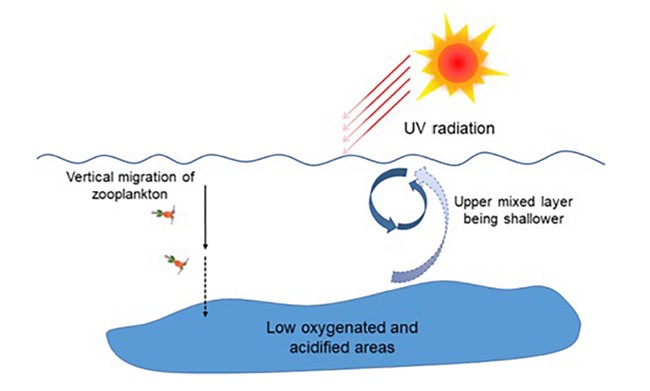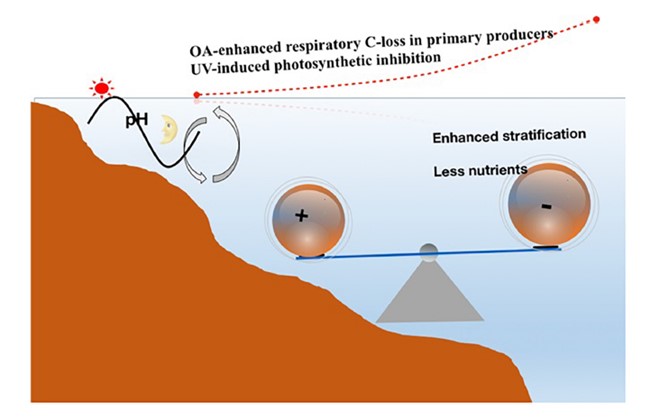近日,高坤山教授等应邀在Frontiers in Marine Science上发表题为“Effects of Ocean Acidification on Marine Photosynthetic Organisms Under the Concurrent Influences of Warming, UV Radiation, and Deoxygenation”的文章,综述了海洋酸化对光合生物效应方面的研究进展,分析了多重环境压力下酸化的影响机制。
在不同海域、不同物种或不同的实验设计中,酸化、营养盐、UV与升温等因子相互作用,可协同、抵消、或拮抗性地影响初级生产过程。对钙化藻类而言,酸化降低其钙含量,并与UV或升温产生协同效应,进一步降低其钙化作用。对硅藻而言,酸化的正、负效应,依赖于光强与营养盐浓度,营养盐限制或高光条件下抑制其生长。对固氮光合生物而言,酸化或增加或降低其固氮能力,就多重环境压力下的复合效应而言,尚存在较大不确定性。而大型海藻的耐受酸化能力较强,CO2浓度升高能促进其生长。低氧化对初级生产者的影响目前鲜有报道,理论预测低氧化与酸化会影响细胞内CO2与O2的比率,进而影响核酮糖-1,5-二磷酸羧化酶催化的羧化与氧化作用,左右浮游植物净固碳量。
该综述还展望了未来研究趋势,提出了两种科学假说:1)海洋全球变化影响下栖息地退化假说;2)酸化与UV辐射协同影响光合固碳,由近岸向大洋,协同抑制光合固碳的同时,加剧浮游植物呼吸丢碳。
Hypothesis 1: Ocean climate changes-induced habitat degradation. Ocean warming, acidification, and deoxygenation associated with increasing atmospheric CO2 rise. A shoaled upper mixed layer due to warming exposes organisms dwelling there to higher levels of solar radiation. The habitable niche degradation hypothesis: phytoplankton abundance and community structure can be altered within the UML under multiple stressors associated with ocean climate changes; and motile organisms dwelling within the UML are stressed due to increased exposure to solar UV radiation and high levels of PAR, which traps more heat; however, the low O2 and pH waters below the UML hamper downward migration.

Hypothesis 2: Ocean acidification (OA) and UV synergistically enhance carbon loss in surface primary producers. This hypothesis is based on the observational data on UV impacts and results that smaller diatoms decrease their growth rate under OA and nutrient-limitation conditions. Diel pH changes in highly productive coastal waters are shown with a sun and a moon symbol to indicate pH rise with increasing photosynthetic C removal during daytime and pH decline with respiratory CO2 release during night. Note that benthic macroalgae contribute greatly to the diel pH fluctuations, and that their growth and photosynthesis are usually stimulated by rising CO2 associated with OA. The symbols “+” and “–” indicate more positive effects due to OA and UV in coastal non-nutrient-limited waters and negative effects due to OA and UV in oligotrophic offshore waters, where shoaling of upper mixed layer owing to warming reduces upward transport of nutrients from deeper layers.

Reference:
Gao KS*, Beardall J, Hader DP, Hall-Spencer JM, Gao G, Hutchins DA. 2019. Effects of ocean acidification on marine photosynthetic organisms under the concurrent influences of warming, UV radiation and deoxygenation. Frontiers in Marine Science, 6: 322.
原文链接:https://www.frontiersin.org/articles/10.3389/fmars.2019.00322/full